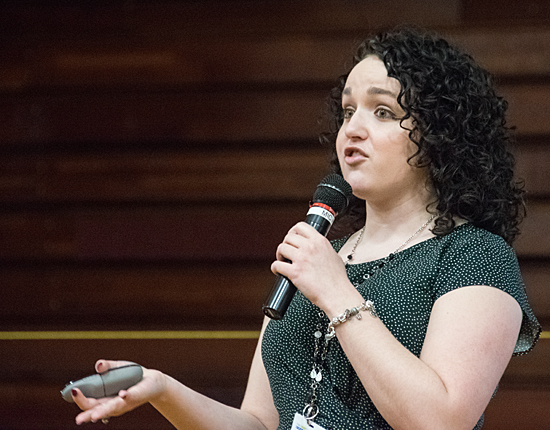Local group releases health assessment
DAVE MOSIER/independent editor
The Van Wert County Health Collaborative released its Community Health Needs Assessment for 2018 on Tuesday during a morning session in the S.F. Goedde Building gymnasium.

Tessa Elliott, MPH, community health improvement coordinator, presented information from the 152-page report, highlighting adult and youth health data compiled last year. National public health accreditation status requires that community health assessments be done at least every five years, with the last Van Wert County assessment completed in 2015.
In addition to providing 2018 health information, the assessment also compares that data with 2015 figures.
Areas covered by the assessment include health care access, adult health behaviors, chronic disease, social conditions, and a youth health category.
Information for the assessment came from written surveys of adults and youths in Van Wert County that were developed in conjunction with health education researchers from the University of Toledo and the Hospital Council of Northwest Ohio, as well as input from a county planning committee. The adult survey included 116 items, while the youth survey included 76 items.
Information from a total of 387 adults and 380 students in grades 6-12 were included in the survey, and responses are considered representative of the entire county.
Some highlights of the assessment are as follows:
Health insurance— Only 1 in 9 county adults (11 percent) are without health insurance, the same as in 2015, with only 1 percent of adults 65 and over without insurance. The population most likely to be without insurance are females age 30-64 (14 percent) and those who make less than $25,000 a year (16 percent).
Sixty-nine percent of adults had a routine checkup in the last year, with that number increasing to 83 percent for those age 65 and older.
Obesity— A total of 33 percent of adults and 18 percent of youths were classified as being obese through BMI classifications, while 39 percent of adults and 18 percent of youths were classified as overweight. Adults classified as obese were most likely to be between the age of 30-64, while adults over age 65 were mostly likely to be overweight. Females were more likely to be obese, while males were more likely to be overweight. Those making less then $25,000 a year were more likely to be obese than those making more than that (43-32 percent). Among youths, those age 17 and over were more likely to be obese (26 percent).
Smoking— A total of 18 percent of adults surveyed were current smokers, up from 14 percent in 2015, while 25 percent were former smokers, up from 21 percent. Those most likely to smoke were adults age 30-64 (20 percent) making less than $25,000 a year (34 percent). A total of 15 percent of county youths had tried smoking, increasing to 19 percent of males and 33 percent of those age 17 and older. Nearly one-fifth of youths who had smoked a whole cigarette did so at 10 years old or younger, and another 20 percent had done so by age 12. A total of 4 percent of youths were current smokers, while 10 percent had used e-cigarettes.
Drinking— 56 percent of county adults had at least one alcoholic drink in the past month and would be considered current drinkers. 24 percent of adults reported binge drinking (five or more alcoholic drinks for males and four or more drinks for females) in the last month. Those under 30 (4.6 drinks) and making less than $25,000 a year (5 drinks) were most likely to drink the most. Approximately 41 percent of county youths, and 68 percent of those age 17 and older, had at least one drink in their life, with 15 percent having at least one drink in the past 30 days. Of those who drank, a whopping 70 percent were considered binge drinkers.
Drug misuse— 8 percent of adults misused prescription medications in the past six months, with those under 30 most likely to abuse prescription drugs. 3 percent of youths also abuse prescription medication, with those ages 14-16 most likely to do so.
Adverse Childhood Experiences— Adults who had four or more ACEs (including physical, sexual, emotional, financial, or verbal abuse) in their life totaled 12 percent, with females and those ages 30-64 most likely to have had ACEs. A total of 24 percent of youths had three or more ACEs, with females and those 17 and older most likely to have experienced ACEs. 39 percent of youths said they were bullied, down from 54 percent in 2015, with females (48 percent) and those 17 and older (44 percent) most likely to be bullied.
Sexual behavior— 70 percent of adults reported having sexual intercourse in the last year, with 65 percent having one partner, 5 percent having more than one partner, and 30 percent having no partners. Those least likely to have sex partners were females (33 percent), although they were also more likely to have multiple partners (8 percent), as well as those age 65 and older (67 percent) and those making less than $25,000 a year (49 percent). 30 percent of county youths surveyed had had sexual intercourse in their lifetime, with males and those age 17 and older most likely to have sex.
Cardiovascular health— Risk factors for cardiovascular health were as follows: 45 percent of respondents were diagnosed with high cholesterol, 36 percent with high blood pressure, 33 percent were obese, 25 percent were sedentary, 18 percent smoked, and 11 percent had diabetes. 6 percent of county adults reported surviving a heart attack, while 3 percent had survived a stroke.
Cancer— 18 percent of county adults had been diagnosed with cancer at some time in their life.
Other health problems — About 34 percent of adults were diagnosed with arthritis, 15 percent with asthma, and 11 percent with diabetes.
Suicide risk— 2 percent of adults surveyed considered attempting suicide in the past year, with 26 percent reporting that they or a family member were diagnosed with, or treated for, anxiety or emotional problems in the past year. 8 percent of adults reported feeling sad or hopeless almost every day for two or more weeks in a row, with those under 30 (14 percent) and those making less than $25,000 (17 percent) most likely to have felt that way. Of some concern was the fact that 15 percent of youths had seriously considered attempting suicide in the past year, with 5 percent actually attempting suicide in that period. The top three causes for anxiety, stress, or depression among youths were academic success (32 percent), fight with friends (30 percent), and self-image (29 percent). 27 percent of county youths surveyed reported feeling sad or hopeless almost every day for two weeks or more in a row (up from 21 percent in 2015), with females (35 percent), and those age 14-16 (32 percent) most likely to feel that way.
Those wanting a copy of the full health assessment can call Van Wert Health at 419.238.2390 or email info@vanwerthealth.org to request a copy.
POSTED: 04/03/19 at 8:40 am. FILED UNDER: News







